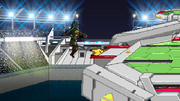
|
This article may require some new images.
Whether it is a new image or simply a higher quality update, upload the new file and add it into the article. Remember to always upload an updated file under the same name as the older version to supersede it. |
A guard break is a set of techniques in the Super Smash Flash games that counter edgeguarding. Guard breaking strategies have developed in response to new ways of edgeguarding opponents. However, if a player is allowing his/her opponent to recover (there is no guard) back to thde stage, there was no break. If a recovery is not taking place close to a ledge, that is also not considered a break, even if a guard is in place.
General strategies
Spike guard
A character with a powerful meteor smash will often have their guarding strategy centered around meteor smashing, especially if the character lacks other good guarding strategies, such as Donkey Kong. This guard can be broken by trying to avoid being under the guarder, but certain situations will call for the recovering fighter to use an up aerial. Dodging to avoid the meteor smash will break the guard, but sometimes mistiming it will have guarded be meteor smashed or leave them in a situation where they are unable to recover.
Grab guard
Characters with strong throws or even air throws such as Chomp will try to guard by grabbing the guarded on the approach. This guard can be broken by dodging at a critical time, sweet spotting the ledge, or perfect timing of a forward aerial. However, a grab guard is not restricted to approaching so the grab guard can be continued if both characters are still positioned near the ledge even after a break was successful.
Smash guard
The most basic and common guard is the preparation of a smash attack upon recovery. It can be broken with an aerial attack, a dodge, or sweet spotting the ledge. This guard is often used to score a KO at high percentages because of positioning so the break should be executed with care. If attempted at low damage, it is normally intended to be accompanied by another guarding strategy.
Projectile guard
Characters with strong and directed projectiles such as Link, Zelda, and Samus can use their projectiles to begin a guard when the opponent is positioned far from the ledge. Zelda's Din's Fire is hard to break because the direction the projectile goes in can be controlled and has a lot of range. Perfect dodging followed by a strong aerial or carefully sweet spotting the ledge is required to break this guard. This can be performed with items as well, using the items themselves as projectiles.
Edge-hogging

In order the prevent an opponent from grabbing the ledge, players will grab the ledge themselves to prevent the opponent from recovering. The guarder cannot attack the guarded when doing this guard, but most of the time the guarder will not do this until the guarded has done their third jump or the guarder knows that the guarded only possible recovery option is the ledge. The guarded has a few options to break this guard because of the invincibility frames the guarder receives from grabbing the ledge. The only options left is to use a projectile or perfect time an attack after the invincibility frames are gone.
Off-stage guard
Off-stage guarding is a risky, but effective method of edge guarding. The guarder leaves the stage to use a powerful aerial attack to finish the guarded off. The best way to break this guard is to dodge, or hit the guarder first. However, the guarder will normally resort to edgehogging if the off-stage guard fails. Sometimes, the guarded could make it to the ledge and edgehog the guarder.
Sacrificial KO "break"
If a character has a useful Sacrificial KO move, it can used to break edge guards. In certain situations the recovering fighter will think he/she has no chance of returning to the stage or ledge when a edge guarder is in place. So they will try to drag the guarder down with them. Moves like Inhale and Chomp are good examples of this. For obvious reasons, a player should not do this if they have one stock and/or the opponent has more.
